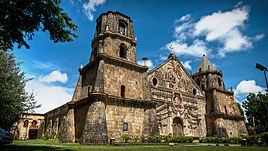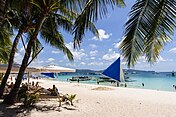Western Visayas (Hiligaynon: Kabisay-an Nakatundan; Tagalog: Kanlurang Kabisayaan or Kanlurang Visayas) is an administrative region in the Philippines, numerically designated as Region VI. It consists of six provinces (Aklan, Antique, Capiz, Guimaras, Iloilo and Negros Occidental) and two highly urbanized cities (Bacolod and Iloilo City). The regional center is Iloilo City.[3] The region is dominated by the native speakers of four Visayan languages: Hiligaynon, Kinaray-a, Aklanon and Capiznon. The land area of the region is 20,794.18 km2 (8,028.68 sq mi), and with a population of 7,954,723 inhabitants, it is the second most populous region in the Visayas after Central Visayas.[4]
Western Visayas Kabisay-an Nakatundan Kanlurang Kabisayaan | |
|---|---|
 Location in the Philippines | |
| Coordinates: 11°08′N 122°32′E / 11.13°N 122.53°E | |
| Country | |
| Island group | Visayas |
| Regional center | Iloilo City |
| Largest city | Bacolod |
| Area | |
| • Total | 20,794.18 km2 (8,028.68 sq mi) |
| Highest elevation | 2,465 m (8,087 ft) |
| Population (2020 census)[1] | |
| • Total | 7,954,723 |
| • Density | 380/km2 (990/sq mi) |
| Time zone | UTC+8 (PST) |
| ISO 3166 code | PH-06 |
| Provinces | |
| Independent Cities | |
| Component cities | |
| Municipalities | 117 |
| Barangays | 4,051 |
| Cong. districts | 16 |
| Languages | |
| GDP (2023) | ₱1.24 trillion $22.38 billion[2] |
| Growth rate | |
| HDI | |
| HDI rank | 5th in the Philippines (2019) |
On May 29, 2015, the region was realigned, when Western Visayas (Region VI) lost both the province of Negros Occidental and the highly urbanized city of Bacolod to the newly formed Negros Island Region. However, the region was dissolved, resulting in the return of Negros Occidental and Bacolod to Western Visayas Region on August 9, 2017.
Etymology edit
The region's current name is in reference to its geographic position in the greater Visayas area.
History edit
Regions first came into existence on September 24, 1972, when the provinces of the Philippines were organized into 11 regions by Presidential Decree No. 1 as part of the Integrated Reorganization Plan by President Ferdinand Marcos. The provinces of Aklan, Antique, Capiz, Iloilo (including its then-subprovince of Guimaras), and Negros Occidental were grouped together to form the Western Visayas region.
The province of Palawan was transferred to Region VI (Western Visayas) on May 23, 2005, by Executive Order 429.[5] The Department of the Interior and Local Government announced in June 2005 that the transfer had been completed.[6]However, Palaweños criticized the move, citing a lack of consultation, with most residents in Puerto Princesa City and all municipalities but one preferring to stay with Region IV-B. Consequently, Administrative Order No. 129 was issued on August 19, 2005, to address this backlash. This Order directed the abeyance of Executive Order 429 pending the approval of an implementation plan for the orderly transfer of Palawan from Region IV-B to Region VI.[7]Hence, Palawan is currently still part of Region IV-B.
By virtue of Executive Order No. 183 issued on May 29, 2015, by President Benigno Aquino III, the province of Negros Occidental and its capital, Bacolod, were both removed from Western Visayas in order to form the Negros Island Region along with Negros Oriental.[8] But later regained Negros Occidental and its capital, Bacolod City back into Western Visayas on August 9, 2017, when President Rodrigo Duterte dissolved the Negros Island Region, revoking Executive Order No. 183, s. 2015 through the signage of Executive Order No. 38, citing the reason of the lack of funds to fully establish the NIR according to Benjamin Diokno, the Secretary of Budget and Management.[9]
Geography edit
Western Visayas consists of the major island of Panay and the smaller Guimaras, as well as several outlying islands. It also includes the western half of the larger island of Negros. The region is bordered to the north by the Sibuyan Sea, northeast by the Visayan Sea, east by the province of Negros Oriental in Central Visayas, south by the Iloilo Strait and Panay Gulf, and west by the Sulu Sea.
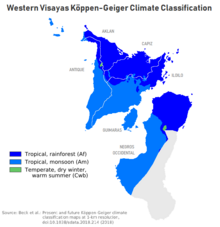
Administrative divisions edit
Provinces edit
Western Visayas consists of 6 provinces, 2 highly urbanized cities, 14 component cities, 117 municipalities and 4,051 barangays.
| Province or HUC | Capital | Population (2020)[10] | Area[11][failed verification] | Density | Cities | Muni. | Barangay | |||||
|---|---|---|---|---|---|---|---|---|---|---|---|---|
| km2 | sq mi | /km2 | /sq mi | |||||||||
| Aklan | Kalibo | 7.7% | 615,475 | 1,760.30 | 679.66 | 350 | 910 | 0 | 17 | 327 | ||
| Antique | San Jose de Buenavista | 7.7% | 612,974 | 2,730.67 | 1,054.32 | 220 | 570 | 0 | 18 | 590 | ||
| Capiz | Roxas | 10.1% | 804,952 | 2,594.64 | 1,001.80 | 310 | 800 | 1 | 16 | 473 | ||
| Guimaras | Jordan | 2.4% | 187,842 | 611.87 | 236.24 | 310 | 800 | 0 | 5 | 98 | ||
| Iloilo | Iloilo City | 25.8% | 2,051,899 | 4,997.64 | 1,929.60 | 410 | 1,100 | 1 | 42 | 1,721 | ||
| Negros Occidental | Bacolod | 33.0% | 2,623,172 | 7,844.12 | 3,028.63 | 330 | 850 | 12 | 19 | 601 | ||
| Bacolod | † | — | 7.6% | 600,783 | 160.71 | 62.05 | 3,700 | 9,600 | — | — | 61 | |
| Iloilo City | † | — | 5.8% | 457,626 | 78.34 | 30.25 | 5,800 | 15,000 | — | — | 180 | |
| Total | 7,954,723 | 20,778.29 | 8,022.54 | 380 | 980 | 16 | 117 | 4,051 | ||||
| ||||||||||||
Governors and vice governors edit
| Province | Image | Governor | Political Party | Vice Governor | |
|---|---|---|---|---|---|
 | Jose Enrique Miraflores | PDP–Laban | Reynaldo Quimpo | ||
 | Rhodora Cadiao | NUP | Edgar Denosta | ||
 | Fredenil Castro | Lakas | James Magbanua | ||
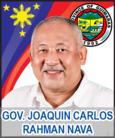 | Joaquin Carlos Rahman Nava | NUP | John Edward Gando | ||
 | Arthur Defensor Jr. | NUP | Christine Garin | ||
 | Eugenio Jose Lacson | NPC | Jeffrey Ferrer | ||
Cities edit
- † Regional center
| City | Population (2020)[10] | Area | Density | City class | Income class | Province | ||
|---|---|---|---|---|---|---|---|---|
| km2 | sq mi | /km2 | /sq mi | |||||
| Bacolod | 600,783 | 160.71 | 62.05 | 3,700 | 9,600 | Highly urbanized | 1st | Negros Occidental |
| Bago | 191,210 | 401.20 | 154.90 | 480 | 1,200 | Component | 2nd | Negros Occidental |
| Cadiz | 158,544 | 524.57 | 202.54 | 300 | 780 | Component | 2nd | Negros Occidental |
| Escalante | 96,159 | 192.76 | 74.43 | 500 | 1,300 | Component | 4th | Negros Occidental |
| Himamaylan | 116,240 | 367.04 | 141.71 | 320 | 830 | Component | 3rd | Negros Occidental |
| † Iloilo City | 457,626 | 78.34 | 30.25 | 5,800 | 15,000 | Highly urbanized | 1st | Iloilo |
| Kabankalan | 200,198 | 697.35 | 269.25 | 290 | 750 | Component | 1st | Negros Occidental |
| La Carlota | 66,664 | 137.29 | 53.01 | 490 | 1,300 | Component | 4th | Negros Occidental |
| Passi | 88,873 | 251.39 | 97.06 | 350 | 910 | Component | 4th | Iloilo |
| Roxas | 179,292 | 95.07 | 36.71 | 1,900 | 4,900 | Component | 1st | Capiz |
| Sagay | 148,894 | 330.34 | 127.54 | 450 | 1,200 | Component | 3rd | Negros Occidental |
| San Carlos | 132,650 | 451.50 | 174.33 | 290 | 750 | Component | 2nd | Negros Occidental |
| Silay | 130,478 | 214.80 | 82.93 | 610 | 1,600 | Component | 3rd | Negros Occidental |
| Sipalay | 72,448 | 379.78 | 146.63 | 190 | 490 | Component | 4th | Negros Occidental |
| Talisay | 108,909 | 201.18 | 77.68 | 540 | 1,400 | Component | 4th | Negros Occidental |
| Victorias | 90,101 | 133.92 | 51.71 | 670 | 1,700 | Component | 4th | Negros Occidental |
Demographics edit
| Year | Pop. | ±% p.a. |
|---|---|---|
| 1903 | 1,083,474 | — |
| 1918 | 1,347,249 | +1.46% |
| 1939 | 2,173,579 | +2.30% |
| 1948 | 2,530,517 | +1.70% |
| 1960 | 3,078,305 | +1.65% |
| 1970 | 3,618,326 | +1.63% |
| 1975 | 4,146,390 | +2.77% |
| 1980 | 4,525,615 | +1.77% |
| 1990 | 5,393,333 | +1.77% |
| 1995 | 5,776,938 | +1.30% |
| 2000 | 6,211,038 | +1.57% |
| 2007 | 6,843,643 | +1.35% |
| 2010 | 7,102,438 | +1.36% |
| 2015 | 7,536,383 | +1.14% |
| 2020 | 7,954,723 | +1.07% |
| Data in 2015 includes Negros Occidental and Bacolod. Source: Philippine Statistics Authority[1][12] | ||
Languages edit
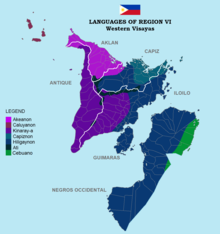
The native languages of Western Visayas are:
- Aklanon/Akeanon, spoken in Aklan and northwestern Capiz.
- Capiznon, spoken in Capiz, northeastern Iloilo, and eastern Aklan.
- Cebuano, spoken in northeastern Negros Occidental.
- Hiligaynon, spoken in Iloilo, Negros Occidental, Guimaras, Capiz, Antique, and Aklan. It is the regional lingua franca.
- Kinaray-a, spoken in Antique, southwestern half of Iloilo, Guimaras, western Capiz, and southwestern Aklan.
- Malaynon, spoken in northwestern Aklan including Boracay Island.
- Caluyanon, spoken in the Semirara Islands (Semirara, Caluya, and Sibay Islands).
Economy edit
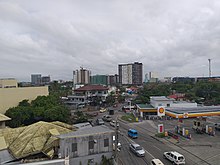
Poverty Incidence of Western Visayas
10 20 30 40 2006 29.08 2009 30.80 2012 29.14 2015 24.60 2018 16.32 2021 13.80 Source: Philippine Statistics Authority[13][14][15][16][17][18][19][20] |
The major trading and commercial centers of Western Visayas are the cities of Iloilo City in Iloilo; Bacolod and Kabankalan in Negros Occidental; Roxas City in Capiz; San Jose in Antique; and Kalibo in Aklan. Metro Iloilo, composed of Iloilo City and the municipalities of Oton, San Miguel, Pavia, Leganes, Santa Barbara, and Cabatuan, and the island province of Guimaras, is the center for commercial, financial, and industrial activities in the region.
Transportation edit
Airports edit
International edit
Domestic edit
- Godofredo P. Ramos Airport (Caticlan, Malay, Aklan)
- Roxas Airport (Roxas City, Capiz)
- Evelio Javier Airport (Funda-Dalipe, San Jose de Buenavista, Antique)
Municipal edit
- Semirara Airport (Semirara Island, Caluya, Antique)
Other edit
- Sipalay Airport (Sipalay, Negros Occidental)
- Kabankalan City Domestic Airport (Kabankalan, Negros Occidental)
- Sicogon Airport (Sicogon Island, Carles, Iloilo)
- Guimaras Airport (Buenavista, Guimaras)
Rail edit
Proposals to re-connect again Iloilo-Roxas, Iloilo-Kalibo, Iloilo-Malay (Aklan) and Iloilo-San Jose (Antique) from the Iloilo City via rail was included in the revival of the currently defunct Panay Railways network which has a station in Santa Barbara town proper.[21]
References edit
External links edit
 Media related to Western Visayas at Wikimedia Commons
Media related to Western Visayas at Wikimedia Commons Western Visayas travel guide from Wikivoyage
Western Visayas travel guide from Wikivoyage Geographic data related to Western Visayas at OpenStreetMap
Geographic data related to Western Visayas at OpenStreetMap
